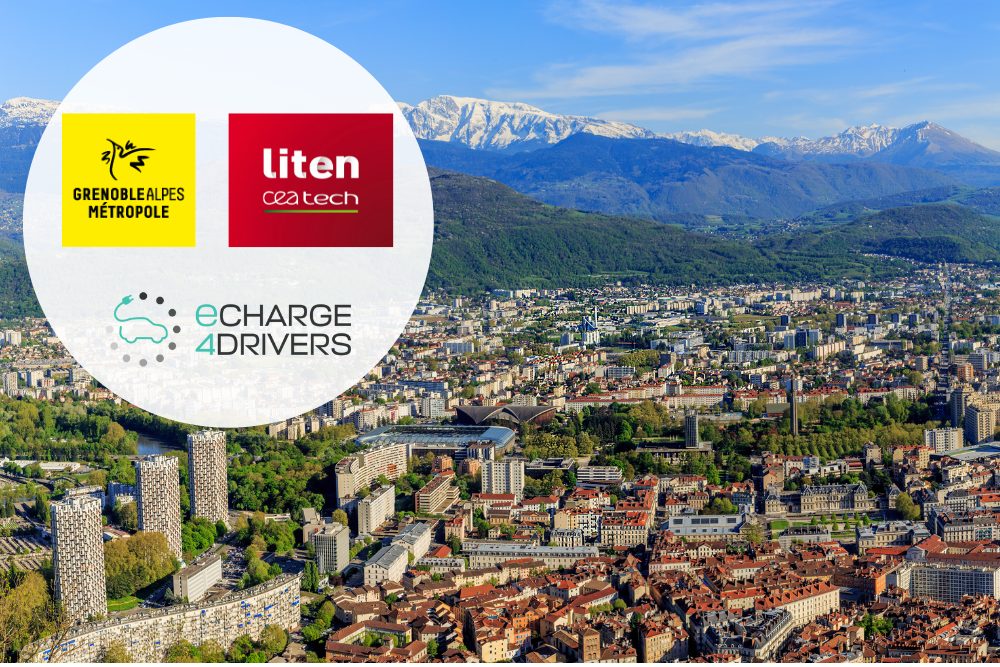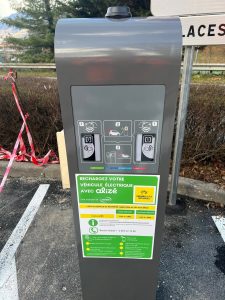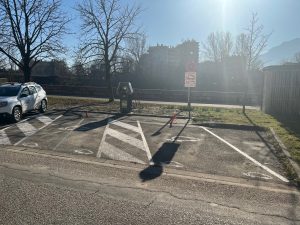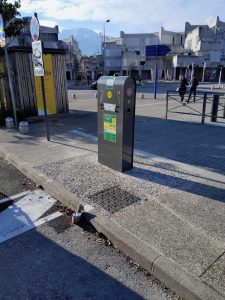In the Grenoble-Alpes demonstration site, eCharge4Drivers partners Grenoble Alpes Métropole (GAM) and CEA are showcasing innovative user-centric charging solutions, including unique charging points on lamp posts, new charging stations, smart charging points and new tariff schemes to encourage the uptake of electric vehicles. Discover below the latest updates on the demonstrations in Grenoble!
Installation of new charging stations
To enhance the user experience, GAM decided to install new charging stations to replace the ageing infrastructure in Grenoble, offering safer and more reliable equipment for the users. Different kinds of charging stations, including AC, DC, from 7 kW up to 25 kW, were installed on the streets and in park-and-ride facilities.
- 7 kW AC wallbox, in a park and ride facility, installed in Eybens intalled in March 2023
- 7 kW AC wallbox, in a park and ride facility, installed in Eybens intalled in March 2023
- 22-25 kW AC/DC wallbox, on street, installed in La Tronche, in February 2023
- 22 kW AC wallbox, on street, installed in Saint Martin d’Hères in February 2023
 Charging points on lamp posts
Charging points on lamp posts
GAM also set out to explore the feasibility and user acceptance of charging points on lamp posts, which will be installed in areas where there is no or limited space for charging stations on the pavement. The installation is located in Varces and Claix, two cities in the Grenoble urban area, and is accessible to all users. To make this possible, feasibility studies have been carried out on each site and a number of technical constraints had to be overcome. For example, power supply is needed during night and day to allow charging, but public lighting is switched off during the day and many cities also switch off night lighting between 1 and 6 am. In total, six charging points on lamp posts are expected to be installed by the end of 2023.
New tariff schemes
New tariff schemes for EV charging were also introduced in Grenoble to balance revenue and operational costs in the long run, while giving priority to complement charging and encouraging vehicle rotation. In application since April 2022, the new pricing is based on kWh consumption and space occupation time, taking into account space availability and related parking policies, with two distinct zones.
Smart charging solution for EV charging infrastructure located near office buildings
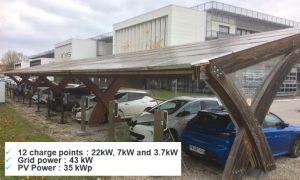 In the Grenoble demonstration site, CEA is responsible for the development, deployment and validation testing of a Smart Charging Energy Management (EMS) system that can control the charging infrastructure of electric vehicles, maximise photovoltaic self-production and minimise the cost of charging. The system respects user preferences while taking into account local grid constraints and electricity pricing.
In the Grenoble demonstration site, CEA is responsible for the development, deployment and validation testing of a Smart Charging Energy Management (EMS) system that can control the charging infrastructure of electric vehicles, maximise photovoltaic self-production and minimise the cost of charging. The system respects user preferences while taking into account local grid constraints and electricity pricing.
Because of interoperability reasons, the challenge was to use standard equipment and protocols in the design and development of the Smart Charging EMS system, such as Open Charge Point Protocol (OCPP) and Open Charge Point Interface (OCPI), enabling it to interface it with the backend of any Charge Point Operator and eMobility Service Providers.
The Smart Charging EMS system developed as part of the project was first tested in the laboratory, and then deployed in the CEA-INES charging infrastructure. The smart charging system has been operational since December 2022 and was demonstrated on several types of vehicles with the participation of 30 users. The demonstration showed the following results (until September 2023):
- More than 2064 charging sessions have been carried out
- The total energy transferred to vehicles is around 21 432 kWh (~139 070 km)
- The self-production ratio is 56% on average, and as high as 95% in some cases
- The charging cost reduction thanks to smart charging using photovoltaic energy is close to 20%
- The charging time flexibility offered by EV users is three hours on average
- 27% of users provide their preferences on the state of charge at arrival and their expected departure time through the mobile app
- The frequency of use of smart charging is 76%
- The quality of smart charging service is recorded up to 99%
- The unavailability rate due to technical issues (CP) is around 2%.
“The car of tomorrow will be electric. This is a national and European orientation. In this perspective, and in connection with the development of the low-emission zone which will see the need for professionals and then for individuals to equip themselves with less polluting vehicles, it is imperative, locally, to change gear and to scale up the installation of electric charging stations. This is what we are doing and what we are preparing for in the years to come, including through more advantageous charging pricing at park-and-ride facilities in order to encourage connections as far upstream as possible to public transport.” Pierre Verri, Vice-President of Grenoble-Alpes Métropole in charge of air, energy and climate, and Sylvain Laval, President of SMMAG
Discover in the video below how the Smart Charging EMS system works!
